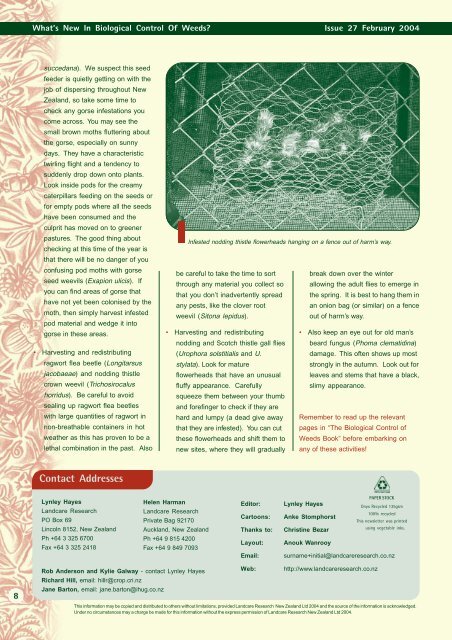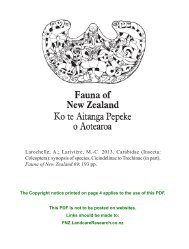Clarifying a grey area (PDF File, 878.6 KB - Landcare Research
Clarifying a grey area (PDF File, 878.6 KB - Landcare Research
Clarifying a grey area (PDF File, 878.6 KB - Landcare Research
Create successful ePaper yourself
Turn your PDF publications into a flip-book with our unique Google optimized e-Paper software.
8<br />
What’s New In Biological Control Of Weeds? Issue 27 February 2004<br />
succedana). We suspect this seed<br />
feeder is quietly getting on with the<br />
job of dispersing throughout New<br />
Zealand, so take some time to<br />
check any gorse infestations you<br />
come across. You may see the<br />
small brown moths fluttering about<br />
the gorse, especially on sunny<br />
days. They have a characteristic<br />
twirling flight and a tendency to<br />
suddenly drop down onto plants.<br />
Look inside pods for the creamy<br />
caterpillars feeding on the seeds or<br />
for empty pods where all the seeds<br />
have been consumed and the<br />
culprit has moved on to greener<br />
pastures. The good thing about<br />
checking at this time of the year is<br />
that there will be no danger of you<br />
confusing pod moths with gorse<br />
seed weevils (Exapion ulicis). If<br />
you can find <strong>area</strong>s of gorse that<br />
have not yet been colonised by the<br />
moth, then simply harvest infested<br />
pod material and wedge it into<br />
gorse in these <strong>area</strong>s.<br />
Harvesting and redistributing<br />
ragwort flea beetle (Longitarsus<br />
jacobaeae) and nodding thistle<br />
crown weevil (Trichosirocalus<br />
horridus). Be careful to avoid<br />
sealing up ragwort flea beetles<br />
with large quantities of ragwort in<br />
non-breathable containers in hot<br />
weather as this has proven to be a<br />
lethal combination in the past. Also<br />
Contact Addresses<br />
Lynley Hayes<br />
<strong>Landcare</strong> <strong>Research</strong><br />
PO Box 69<br />
Lincoln 8152, New Zealand<br />
Ph +64 3 325 6700<br />
Fax +64 3 325 2418<br />
Helen Harman<br />
<strong>Landcare</strong> <strong>Research</strong><br />
Private Bag 92170<br />
Auckland, New Zealand<br />
Ph +64 9 815 4200<br />
Fax +64 9 849 7093<br />
Rob Anderson and Kylie Galway - contact Lynley Hayes<br />
Richard Hill, email: hillr@crop.cri.nz<br />
Jane Barton, email: jane.barton@ihug.co.nz<br />
Infested nodding thistle flowerheads hanging on a fence out of harm’s way.<br />
be careful to take the time to sort<br />
through any material you collect so<br />
that you don’t inadvertently spread<br />
any pests, like the clover root<br />
weevil (Sitona lepidus).<br />
Harvesting and redistributing<br />
nodding and Scotch thistle gall flies<br />
(Urophora solstitialis and U.<br />
stylata). Look for mature<br />
flowerheads that have an unusual<br />
fluffy appearance. Carefully<br />
squeeze them between your thumb<br />
and forefinger to check if they are<br />
hard and lumpy (a dead give away<br />
that they are infested). You can cut<br />
these flowerheads and shift them to<br />
new sites, where they will gradually<br />
Editor: Lynley Hayes<br />
Cartoons: Anke Stomphorst<br />
Thanks to: Christine Bezar<br />
Layout: Anouk Wanrooy<br />
break down over the winter<br />
allowing the adult flies to emerge in<br />
the spring. It is best to hang them in<br />
an onion bag (or similar) on a fence<br />
out of harm’s way.<br />
Also keep an eye out for old man’s<br />
beard fungus (Phoma clematidina)<br />
damage. This often shows up most<br />
strongly in the autumn. Look out for<br />
leaves and stems that have a black,<br />
slimy appearance.<br />
Remember to read up the relevant<br />
pages in “The Biological Control of<br />
Weeds Book” before embarking on<br />
any of these activities!<br />
Email: surname+initial@landcareresearch.co.nz<br />
Web: http://www.landcareresearch.co.nz<br />
PAPER STOCK<br />
Onyx Recycled 135gsm<br />
100% recycled<br />
This newsletter was printed<br />
using vegetable inks.<br />
This information may be copied and distributed to others without limitations, provided <strong>Landcare</strong> <strong>Research</strong> New Zealand Ltd 2004 and the source of the information is acknowledged.<br />
Under no circumstances may a charge be made for this information without the express permission of <strong>Landcare</strong> <strong>Research</strong> New Zealand Ltd 2004.
















